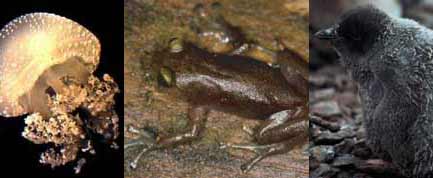8 Signs the Animal Kingdom Is Out of Whack

A polar bear clinging to a melting iceberg may the poster child for global warming, but rising temperatures, pollution and other human activity are also affecting the animal kingdom in far subtler ways. Like the proverbial canary in the coal mine, the natural world could be giving us other signs that human intervention has knocked it way off kilter.
Some recent examples:
1. Earlier Migration: Several bird species are making their annual northward jaunt slightly ahead of schedule in recent springs, as the East Coast of the United States heats up, according to a study detailed in the June issue of the journal Global Change Biology. The report confirms similar studies dating back to 2006. Early birds may not sound like a huge deal, but scientists warn that long-distance migrators who start out in South America, and therefore lack cues about the timing of spring in Northern Hemisphere destinations, will be less able to keep pace with the changing climate. "Trees and shrubs are further along in their development, and different groups of insects are out," said lead author Abraham Miller-Rushing of Boston University. "Spring is coming earlier for most other plants and animals, but not for the long-distance migratory birds. Thus, these long-distance migrant birds may need to learn to eat different sources of food or face other challenges because of the changes in timing."
2: Jellyfish Rule: An outbreak of jellyfish in oceans across the planet has resulted from the stinging creatures hitching rides on ships that circumnavigate the globe. In fact, studies suggest that almost a quarter of all marine species in international harbors are alien transplants, thanks to human-assisted dispersal.
3: Food Web Contaminated. Scientists said last month that they found toxic pollutants in nine deep-sea species of cephalopods, a class of mollusks that includes octopuses, squid, cuttlefish and nautiluses. Among the contaminants were at least two banned in the United States in the 1970s: dichloro-diphenyl-trichloroethane (DDT) and polychlorinated biphenyls (PCBs). Scientists say it's further evidence that contaminants make their way deep into the marine food web.
4. Heading for the Hills: Thirty species of reptiles and amphibians have fled uphill to cooler climes as global warming has caused the mercury to rise. We could see a rash of extinctions occurring between 2050 and 2100, scientists say, because higher ground will eventually run out.
5. Penguins in Peril: A rapid population decline among penguins because, in addition to a warming planet, they face the triple whammy of oil pollution, depletion of fisheries and aggressive coastline development. "Penguins are among those species that show us that we are making fundamental changes to our world," said Dee Boersma, a University of Washington biology professor who has studied the flightless birds for more than 25 years. "The fate of all species is to go extinct, but there are some species that go extinct before their time and we are facing that possibility with some penguins.
Get the world’s most fascinating discoveries delivered straight to your inbox.
6. Sea-Life Shift: Scientists see a notable shift in the composition of coastal marine animal communities, caused in part by changing ocean temperatures, from vertebrates (fish) to invertebrates (lobsters, squid, and crabs), as well as from bottom-feeders to species that feed higher in the water column. Meanwhile, warm-water species have superseded larger, cool-water species in population size.
7. Migrating Parasite: The parasite Angiostronglyus vasorum, commonly known as "French heartworm," is migrating northward because of rising temperatures. Normally found in southwestern England, the parasite has been detected in dogs admitted to animal hospitals in Scotland. Climbing temperatures in the country have also resulted in a sudden proliferation of slugs and snails.
8. Food Shortages: Plant-loving animals in extremely seasonal environments such as the Arctic struggle to feed themselves because global warming causes their food supply to peak in availability before they can reach breeding grounds. "Think of it like this," said Eric Post, a biologist at Penn State. "You've been out on the town with friends, and on the way home you want to stop off for a bite to eat, but the restaurant you've always gone to has closed early. So you try for one around the corner that's always open a little longer. But when you get to that one, it too is closed. For herbivores, the fact that there are several 'restaurants' — their food patches — dispersed across the landscape isn't useful if they all begin closing at the same time in addition to closing earlier in the season."


